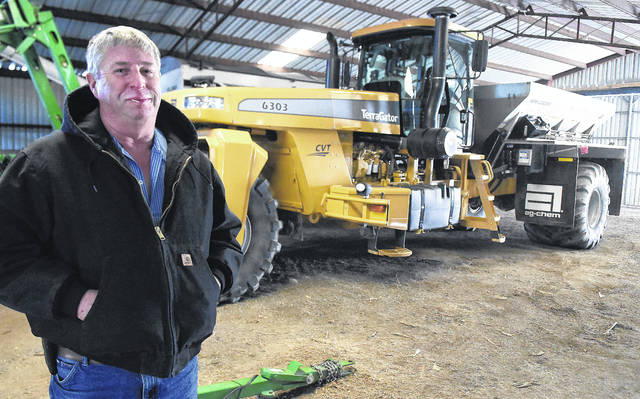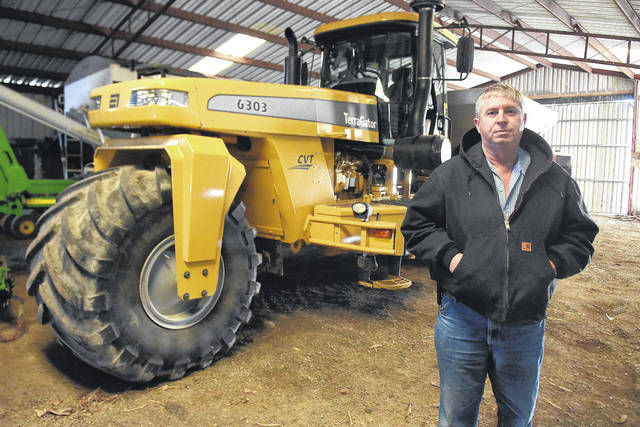

LIMA — The Ohio Department of Agriculture’s new Agricultural Fertilizer Applicator Certification regulation has the potential to be exceptionally beneficial, some area farmers said.
Senate Bill 150 was established to provide farmers with adequate training about best management practices when applying fertilizer to prevent algal blooms in Lake Erie and reduce phosphorus losses from farm fields.
It is a modification made to the 2014 regulation that required farmers to complete a fertilizer certification program if they applied fertilizer to more than 50 acres of land in agricultural production primarily for sale. Fertilizer applied by a planter, commercial applicator and farmers whose crops are not sold are exempt from completing the program.
Jerry McBride, a farmer in Dunkirk in Hardin County, found the information from the certification program to be useful to add to his knowledge about fertilization.
“It opens farmers up to being more mindful of when we apply the fertilizer and when it’s applied and the rates that it’s applied,” he said. “We consider ourselves good stewards, but I guess we need to consider ourselves better stewards and do the best that we can.”
Ted Griffith, a farmer in Ada, who also went through the recertification program, said the most useful concept he learned was the four Rs:
• The “right source” of fertilizer that the crops needs.
• The “right rate” or amount of fertilizer that the crops need.
• The “right time” to apply the fertilizer.
• The “right place” where the fertilizer should be applied.
With the previous certification program, farmers had three years to complete the certification with the County Extension Agriculture & Natural Resources Educators of the Ohio State University. Farmers with Private Pesticide Applicator Licenses were required to complete a two-hour long program, and farmers without a license had to complete a three-hour long one.
Through the new program, farmers who have not yet been recertified will have until March 31. Farmers that need to be certified have the option of either completing a three-hour training program or pass a state test. If they do not complete the program, they can be fined and/or charged with a misdemeanor offense.
Other changes made to the fertilization program require farmers to record the number of acres where they applied fertilizer and the total amount of fertilizer applied. Only one person at a farm or business needs to be certified. The certificate period for farmers without a pesticides license will change from April 1 to March 30. Also, farmers will be provided a 180-day grace period if they are late sending in their applications and/or payment.
Jan Layman, a farmer in Kenton, said he understands the impact that the new program may have on farmers who are not using the correct methods for fertilizing, but he does not necessarily see why experienced farmers are required to complete the program.
“It may help some guys that were possibly not doing the right thing,” he said. “But we were already doing the right thing. We’ve been doing this for over 10 years, so we are probably way ahead of other people.”
Almost every piece of land that he applies fertilizer to goes into the Ohio River watershed and not the Lake Erie watershed, Layman said. He understands that it’s still a problem, but not as big as the Lake Erie issue. He already knows not to spray fertilizer on frozen ground and to pay attention to the weather so it does not wash off and further pollute the river.
Layman takes pride in fertilizing his land. He goes beyond recommended practices and does intensive sampling, he said. Instead of doing grid sampling for two-acre blocks, he completes sampling for four times the amount of land through global positioning system machines that measure the amount of fertilizer based off the results of the soil tests.
“Fertilizer is too expensive to waste,” he said. “So you have to try to get the job done to keep what you spent to and let it do what it’s suppose to do.”
Jay Begg, an Allen County commissioner and farmer with properties throughout Allen County, said that even though he is an experienced farmer, he found the program to be refreshing.
“It was not anything that anybody in production agriculture shouldn’t be able to pass through the provided education,” he said. “It was great reinforcement, and I don’t really see it as really hampering anybody. Hopefully this will make a difference in the water quality of our lakes and our bodies of water. “



